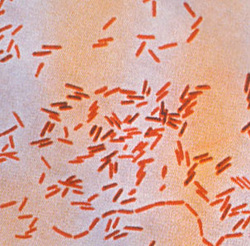Infectious Disease definition - Salmonellosis

Salmonellosis
Salmonellosis is presented with bloody diarrhea. The severity ranges from microscopic pus and blood in the stool to the endotoxin mediated sepsis which occur due to the penetration of the bacteria into the blood stream ( due to some strain /serotypes of the bacteria). Other symptoms and signs may include crampy abdominal and fever.
Salmonellosis is caused by gram negative bacteria with rod shaped. This bacteria is known as Salmonella enterica. Salmonella enterica is a common flora in few animals such as poultry and birds. However infection may occur as a result of ingestion of animal product such as poultry which is contaminated or even contact with infected animals ( birds or poultry). Salmonella enterica will be shed in the human stool for week after the patient has no more episodes of diarrhea. This will increase the chances of fecal oral transmission in food handlers who already heal from salmonella infection.
Salmonella enterica may be detected from the stool culture. Salmonella enterica is a non lactose fermenter. This make it easy to identify Salmonella enteric from cultures of stool by due to its inability to ferment lactose compare to other gram negative rod organism. Besides that it also producing H2S and motile which differentiate it from shingella which is immotile and not producing any H2S.
Salmonella enterica carries its own virulence mechanism which include invasion and endotoxin. Salmonella enterica will bind to the M cells of the intestine. Salmonella enterica will initiate endocytosis. The bacterial will replicate in the endosomes once Salmonella enterica inside the cells ( internalization). The next stage include the stimulation of the inflammatory response after Salmonella enterica managed to enter the subepithelial tissue.
Salmonellosis / salmonella infection can be prevented by promoting a good /proper hand wash technique and proper food preparation. Patient may be dehydrated due to diarrhea and best treated with fluid and electrolytes replacement therapy. Antibiotic may be avoided as it will prolong the carrier stage.
References
1.Chiu, Cheng-Hsun, Lin-Hui Su, and Chishih Chu. "Salmonella enterica serotype Choleraesuis: epidemiology, pathogenesis, clinical disease, and treatment."Clinical microbiology reviews 17.2 (2004): 311-322.
2.Blaser, Martin J., and Lee S. Newman. "A review of human salmonellosis: I. Infective dose." Review of infectious diseases 4.6 (1982): 1096-1106.
Salmonellosis is presented with bloody diarrhea. The severity ranges from microscopic pus and blood in the stool to the endotoxin mediated sepsis which occur due to the penetration of the bacteria into the blood stream ( due to some strain /serotypes of the bacteria). Other symptoms and signs may include crampy abdominal and fever.
Salmonellosis is caused by gram negative bacteria with rod shaped. This bacteria is known as Salmonella enterica. Salmonella enterica is a common flora in few animals such as poultry and birds. However infection may occur as a result of ingestion of animal product such as poultry which is contaminated or even contact with infected animals ( birds or poultry). Salmonella enterica will be shed in the human stool for week after the patient has no more episodes of diarrhea. This will increase the chances of fecal oral transmission in food handlers who already heal from salmonella infection.
Salmonella enterica may be detected from the stool culture. Salmonella enterica is a non lactose fermenter. This make it easy to identify Salmonella enteric from cultures of stool by due to its inability to ferment lactose compare to other gram negative rod organism. Besides that it also producing H2S and motile which differentiate it from shingella which is immotile and not producing any H2S.
Salmonella enterica carries its own virulence mechanism which include invasion and endotoxin. Salmonella enterica will bind to the M cells of the intestine. Salmonella enterica will initiate endocytosis. The bacterial will replicate in the endosomes once Salmonella enterica inside the cells ( internalization). The next stage include the stimulation of the inflammatory response after Salmonella enterica managed to enter the subepithelial tissue.
Salmonellosis / salmonella infection can be prevented by promoting a good /proper hand wash technique and proper food preparation. Patient may be dehydrated due to diarrhea and best treated with fluid and electrolytes replacement therapy. Antibiotic may be avoided as it will prolong the carrier stage.
References
1.Chiu, Cheng-Hsun, Lin-Hui Su, and Chishih Chu. "Salmonella enterica serotype Choleraesuis: epidemiology, pathogenesis, clinical disease, and treatment."Clinical microbiology reviews 17.2 (2004): 311-322.
2.Blaser, Martin J., and Lee S. Newman. "A review of human salmonellosis: I. Infective dose." Review of infectious diseases 4.6 (1982): 1096-1106.
